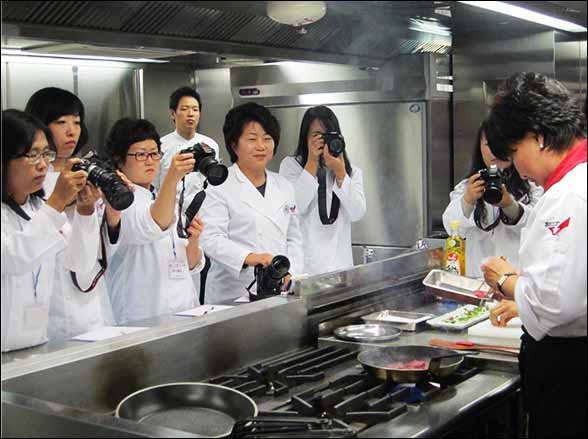USMEF-Korea Exposes Bloggers to International Cuisine
Published: Jan 05, 2012
Since 17 South Korean food bloggers were treated to a four-part international cuisine experience in 2011, their positive reports on the use of U.S. beef and pork have reached between 240,000 and 1.2 million Korean blog readers.

The innovative blogger outreach program developed by USMEF-Korea, which concluded with a special December activity, was funded with support from the USDA Market Access Program (MAP) as well as the Beef Checkoff and Pork Checkoff programs. The initiative involved engaging with nine Korean bloggers who specialize in pork and eight bloggers who focus on beef to expose them to creative uses of U.S. red meat in a wide variety of applications.
“Bloggers create great word-of-mouth messaging among consumers in Korea,” said Jihae Yang, USMEF-Korea director. “This is a highly valued mode of communication as consumers trust the opinion of their peers when making buying decisions. These bloggers, who each reach anywhere from 2,000 readers to more than 10,000 readers per day, are an effective way to build a positive image of U.S. beef and pork.”
“I thought that imported meat was of lower quality than domestic meat,” said one blogger, “but I am attracted to delicious U.S. pork now that I have experienced it.” Another blogger added: “I thought U.S. beef might not be delicious or safe before I actually tried it. Now I changed my view. It’s fresh and delicious.”
The Diverse Cuisines activity was an intensive program that required each blogger to complete four missions and then write about each step in the process.
“Diverse Cuisines Made with U.S. Meat” was the theme of the USMEF-Korea program in 2011 that not only had bloggers cook with U.S. beef and pork, but also brought them to restaurants featuring the products, had them create their own recipes and offer samples through their blogs. The year-end program was the third activity that USMEF-Korea developed specifically for bloggers, with each delivering progressively larger results.

The first step was the launching of the experimental blogger group, which included a cooking class. In the second step, the “taste hunters” visited a restaurant that served U.S. pork or beef. The third mission involved cooking with the products at home, recreating recipes that were presented at the cooking class. The final mission was for each blogger to conduct a free U.S. pork or beef sampling event through their blog. USMEF-Korea supported the sampling with U.S. pork collar butt and beef chuck eye roll.
The program generated broad coverage by the 17 bloggers and the network of other bloggers who follow them. The participating bloggers posted a collective 120 stories about the events, with many picked up by additional influential bloggers. At the lowest estimated blog readership level, the USMEF program reached in excess of 240,000 Korean consumers and may have topped 1.2 million.
Earlier in 2011, USMEF-Korea conducted a special program for pork bloggers led by a Chinese chef from the prestigious Westin Chosun hotel in Seoul. Chef Wang, Hung Lung introduced the bloggers to Beijing-style sweet and sour pork, Szechuan-style spicy collar butt, Shanghai-style pork belly and Guangzhou-style pork.
Later, a group of beef bloggers were led by Korean cuisine cooking instructor Mi Kyung Jung who introduced them to lettuce-wrapped boneless short ribs, barbecued bulgogi with tomato salad, braised short rib with chestnut and vegetables, and Korean-style beef consommé.
The end-of-year program for both beef and pork, led by Italian cuisine instructor Joo Hee Park, featured pork collar butt steak with anchovies and yogurt sauce as well beef tagliata with balsamic sauce and arugula.
“This was a meaningful chance to change consumer biases against U.S. meat safety and quality issues,” reported one blogger. “I learned that U.S. meat processors take their roles seriously in maintaining safe food-handling practices.”
Through the first 10 months of 2011, South Korea purchased 161,118 metric tons (355.2 million pounds) of U.S. pork (including variety meat) valued at $418.1 million, increases of 133 percent in volume and 182 percent in value over 2010.
U.S. beef exports to Korea over the same period reached 129,810 metric tons (286.2 million pounds) valued at $574.9 million, increases of 43 percent in volume at 36 percent in value versus 2010.
